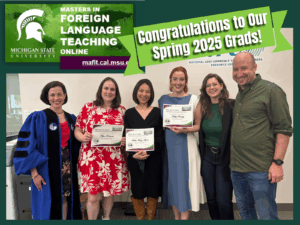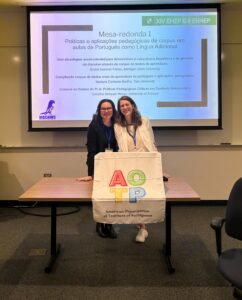Bruna Sommer-Farias (MAFLT Core Faculty) and Mariana Centanin-Bertho at AAAL 2023
AAAL.org | American Association for Applied Linguistics | March 19, 2023
Presenters
Bruna Sommer-Farias, Michigan State University
Mariana Centanin-Bertho, Arizona State University
Lexical bundles are considered “the building blocks of discourse” (Biber et al., 2004) as they are statistically frequent patterns in any register. This study investigated how L2 Portuguese learners improved their writing of job application letters after receiving instruction following principles of data-driven learning and genre-specific writing.
Presentation Abstract
Several studies on learner corpora have described patterns of frequently co-occurring multi-word sequences, especially lexical bundles, and their functions in specific genres (e.g., Xian, Ai & Pae, 2022). While many studies have focused on the comparison between L1 and L2 students’ production (Adel & Erman, 2012), more studies comparing pre-and post-intervention studies informed by corpus-informed materials in languages other than English are needed (Boulton & Vyatkina, 2021). This study investigated the influence of learner corpus-informed materials on L2 learners’ writing, specifically job application letters. The materials used were designed to raise students’ awareness of rhetorical moves and multi-word units in this genre (Sommer-Farias, 2018) based on data from the Multilingual Academic Corpus of Assignments –Writing andSpeech (MACAWS) (Staples et al., 2019-).
The corpus is composed of first and final draft of job application letters written before and after the intervention over 6 semesters in a high-intermediate L2 Portuguese undergraduate writing course, totaling 113 texts and 34,606 word tokens. Lexical bundles were extracted from texts tokenized by sentence, with normalized frequency of 3-and 4-word bundles calculated by individual text. The bundles with highest mean frequency (range of at least 4) were identified by range and dispersion and then classified by functions (Biber, Conrad & Cortes, 2004). Discourse analysis of multi-word units’ placement in sentences and text sections was conducted to identify rhetorical move changes, especially stance bundles, since these functions were addressed in the instructional materials. Bundles expressing politeness such as “thank you for your time” were classified as special bundles for the first time in written genres. Results showed that discourse organizing bundles were as frequent as referential bundles in the final drafts, but stance bundles were more nuanced and aligned with the genre’s purpose after the intervention, e.g., less use of “ I think that” from informal registers.
More on Language Learner Corpora
For more on this topic from the presenters, see:
Sommer-Farias, B., Novikov, A., Picoral, A., Centanin-Bertho, M., & Staples, S. (2022). A multilingual learner corpus for less commonly taught languages. International Journal of Learner Corpus Research, 8(2), 261-282.
For teachers of Portuguese and Russian, visit the corpus here:
Multilingual Academic Corpus of Assignments: Writing and Speech (MACAWS)



